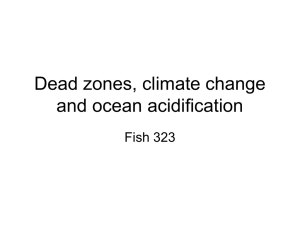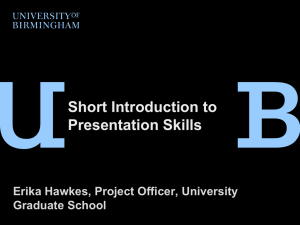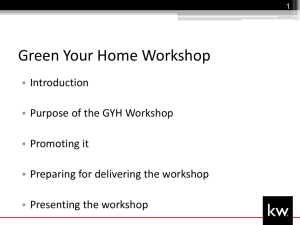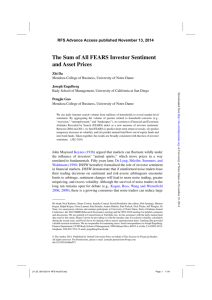Green Your Home Workbook Presenter Version
advertisement
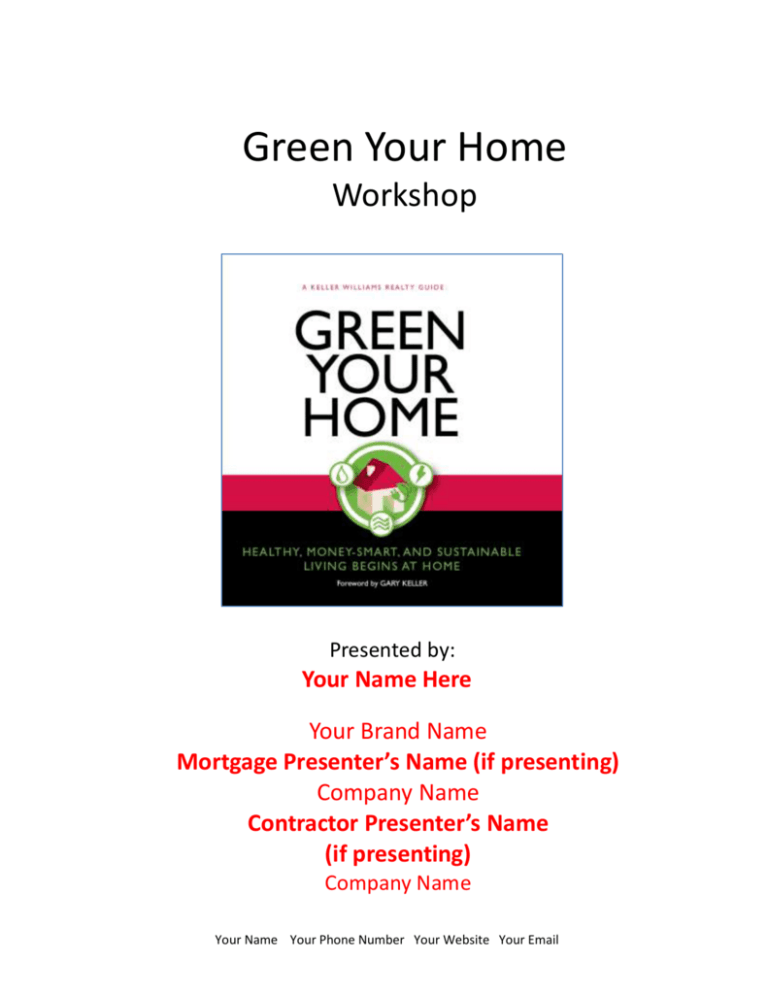
Green Your Home Workshop Presented by: Your Name Here Your Brand Name Mortgage Presenter’s Name (if presenting) Company Name Contractor Presenter’s Name (if presenting) Company Name Your Name Your Phone Number Your Website Your Email What We Cover in the GYH Workshop • • • • • Motivations Laying the Groundwork • • Facts and Fears Six Things to Consider The Four Steps to Greening Your Home • • The Process The Priorities The Three Zones • The Inside, Systems, and Outside Zones Getting It Done About Me • • • Licensed REALTOR® Your credentials (ABR, CRS, etc.) Other credentials Motivations • Human consumption in the past two centuries has released enough carbon dioxide to cause measurable, irreversible changes in the atmosphere. • Landfills are overflowing and disposal of household waste is a growing problem. • Mandatory water conservation is becoming more common, more often. • With knowledge and action, we can make a difference. Your Name Your Phone Number Your Website Your Email Make sure to personalize here – what motivates you? Ask the participants what motivations they have? Green Your Home focuses on the home - as this is where each person can truly have a lasting impact on our community and our environment. What Does It Mean to Be “Green”? • • • Healthy Money-Smart Sustainable Living “Sustainability creates and maintains the conditions under which humans and nature can exist in productive harmony, that permit fulfilling the social, economic and other requirements of present and future generations”* “In preparation of writing the Green Your Home book, the writing team discovered that s the reasons people chose to be green were often very personal, and most of the priorities people spoke of fell into one of these three categories. Being Green is usually associated with sustainability, but most often starts with the desire to be healthier and to save money.” *Sustainability, according to the U.S. Environmental Protection Agency Laying the Groundwork – Fears and Facts Fear: Fact: Read pages 6-10 and be able to speak in more detail about each of these facts. Green is just a bunch of hype Be prepared to While there are some who use the green message for marketing strategies, green is real, green is common sense, and acknowledge and affirm any additional fears and green is likely already a part of your life Fear: Fact: Green is too expensive for me to make a lifestyle change Green can save you money over time. There are simple actions you can take today that cost nothing, yet will yield a measurable impact long term Fear: Fact: Making the lifestyle change to green is too difficult Green is about ease and simplicity, it’s about awareness Fear: Fact: Green will not benefit me personally Green benefits you directly, your family, your neighbors, and your community, now and into the future Your Name Your Phone Number Your Website Your Email ask for facts to counter those fears. Interesting fact: If every American home replaced just one light bulb with a light bulb that's earned the ENERGY STAR, we would save enough energy to light 3 million homes for a year, save about $600 million in annual energy costs, and prevent 9 billion pounds of greenhouse gas emissions per year, Fear: Fact: Going green will not really make a difference A green lifestyle can make all the difference in the world starting with you in your home What other “fears” have you heard about? __________________________________________________________ __________________________________________________________ What “facts” would apply to these fears? __________________________________________________________ __________________________________________________________ Six Things to Consider Before You Begin 1. Focus on resale value 2. Keep your local climate in mind 3. Get more for less 4. Embrace the payback principle 5. Take advantage of potential tax advantages, rebates, and incentives 6. Weigh taking action now vs. later The Four Steps to Greening Your Home 1. Clarify your green priorities 2. Create your green team 3. Build your green project list a. The Inside Zone b. The Systems Zone c. The Outside zone 4. Turn your project list into a plan of action Your Name Your Phone Number Your Website Your Email Step 1: Clarify Your Green Priorities • A Healthy Home (Air) • A Money-Smart Home (Energy) • A Sustainable Home (Water) Step 2: Create Your Green Team • Your Real Estate Agent “As we said earlier, priorities usually aligned with these three categories, and so in the book, these three priorities are the main focus. A Healthy home is mostly associated with air quality A Money-Smart home is mostly focused on reducing energy consumption. The Sustainability focuses on our most precious resource, water. o ___________________________________________ • General Contractors Page 29 Figure 7 has examples o ___________________________________________ • Skilled Tradespeople • • Here, if you have referrals, there is room to add the o ___________________________________________ names of those you like to work with. If you want to open Architects or Design-Build Professionals the floor to others, just be sure o ___________________________________________ to instruct everyone to perform due diligence with Eco-Consultants anyone they hire. o ___________________________________________ • Landscape Architects o ___________________________________________ You should have a local • Home Energy Audit Professionals o Auditor’s name handy here – perhaps even get a referral ___________________________________________ fee, or have one sponsor the workshop. Step 3: Build Your Green Project List • Pay for a professional energy audit • Research the rebates and incentives in your area • Compile a list of possibilities and want-to’s Your Name Your Phone Number Your Website Your Email • Create your list of action items for the home zones • Organize your project list based on your priorities • Make a realistic, comfortable budget • Commit to your time frame and team The Three Zones 1. The Inside Zone (page 46 figure 9) A. A Healthy Inside Zone 1) Bring fresh air inside (passive ventilation and Spot ventilation) 2) Get to know your pollutants. Radon, Mold, Dust, Lead-Based Paint, Asbestos, VOC’s (volatile Organc Compounds) and combustible gas 3) Test for Pollutants – awareness, DIY tests, and hire an expert 4) Keep pollutants out Keep gases vented to outside, keep your home dry, non-toxic and clean B. A Money-Smart Inside Zone 1) Improve your lighting design (natural and artificial) 2) Boost energy efficiency Turn off lights, phantom loads, efficient appliances Your Name Your Phone Number Your Website Your Email C. A Sustainable Inside Zone 1) Get water-wise Water –efficient appliances, and change how you use water indoors 2) Add smart, sustainable interior design features Sustainable paint finishes and flooring products 2. The Systems Zone (page 94 figure 16) A. A Money-Smart Systems Zone 1) Understand how you use energy Look at your energy bills, get a professional audit 2) Pay yourself back with easy energy updates Digital thermostat, update your lighting, and lightbulbs 3) Tighten the building envelope Seal the gaps, ductwork, insulate, and improve your windows performance 4) Maintain your mechanical systems Service your energy equipment yearly at least 5) Work with nature – use natural heating and cooling techniques B. A Healthy Systems Zone 1) Optimize your ventilation system Change the filter, use whole-house ventilation C. A Sustainable Systems Zone 1) Upgrade the water-wise way Understand your water bill, use low-flow aerators, showerheads, and toilets; improve your water heater Your Name Your Phone Number Your Website Your Email Notes: 3. The Outside Zone (Page 141 figure 25) A. A Sustainable Outside Zone 1) Water your lawn more efficiently Water deeply, and less frequently, water very early or late in the day, use a professional sprinkler system, use rainwater “In the Green Your Home book you will receive, there are more details about working through these exercises. The point of this workshop is to familiarize you with the process. I encourage you to read the book and take you time building this list.” 2) Create a sustainable landscape Xeroscaping, native plants, shade tree, wildlife friendly B. C. “The Green Your Home 3) Plant a garden of your own model presented in the book breaks the process Grow your own food and compost down into three zones. Each zone has a priority, but all of A Money-Smart Outside Zone the priorities and elements 1) Improve your energy efficiency from the outside in apply to each zone. Let’s go Plant shade trees, install awnings, consider solar power through them briefly, but again, I want to encourage A Healthy Outside Zone you to read the book for a more thorough 1) Practice safe landscaping techniques understanding.” Less pesticides and more organic care 2) Bring your home outside Green friendly outdoor living spaces Getting It Done Step 4. Turn Your Project List into a Plan of Action 1. 2. 3. 4. Create your list of action items for the home zones Organize your project list based on your priorities Make a realistic, comfortable budget Commit to your time frame Your Name Your Phone Number Your Website Your Email Four Keys to Keeping Green in Good Order 1. Practice proper maintenance for optimal performance 2. Keep it clean 3. Watch for problems 4. Share the rewards of your Green Your Home adventure Next Steps 1. Read Green Your Home 2. Create your project list 3. Prioritize your project list 4. Send me your referrals Q&A Notes: _________________________________________ _________________________________________ _________________________________________ _________________________________________ _________________________________________ _________________________________________ _________________________________________ Your Name Your Phone Number Your Website Your Email



